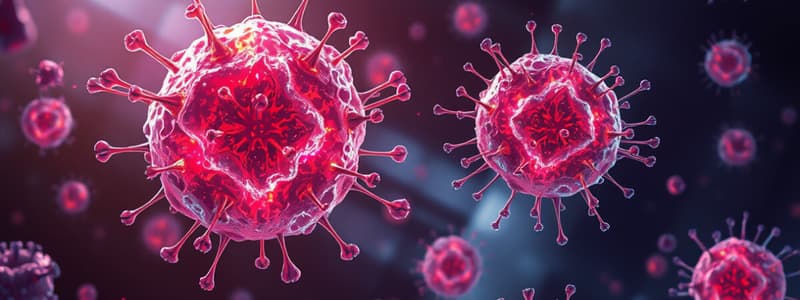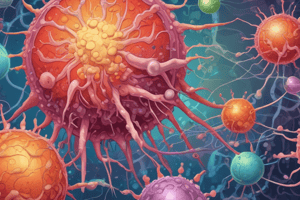Podcast
Questions and Answers
Where in the lymph node would you primarily find T cells?
Where in the lymph node would you primarily find T cells?
- Paracortex (correct)
- Germinal centers
- Medulla
- Cortex
What distinguishes secondary lymphoid follicles from primary lymphoid follicles?
What distinguishes secondary lymphoid follicles from primary lymphoid follicles?
- Presence of germinal centers (correct)
- Increased number of T cells
- Absence of B cells
- Location in the medulla
What type of blood vessels are associated with high endothelial venules in lymph nodes?
What type of blood vessels are associated with high endothelial venules in lymph nodes?
- Afferent lymphatic vessels
- Subcapsular high endothelial venules
- Arteries and veins (correct)
- Efferent lymphatic vessels
Which cells are specifically stained blue in immunohistochemistry within lymphoid follicles?
Which cells are specifically stained blue in immunohistochemistry within lymphoid follicles?
Which structure acts as a site for lymph fluid drainage from the lymph node?
Which structure acts as a site for lymph fluid drainage from the lymph node?
What is the primary function of reticular cells in the stroma of lymph nodes?
What is the primary function of reticular cells in the stroma of lymph nodes?
What is the primary function of the cloacal bursa in birds?
What is the primary function of the cloacal bursa in birds?
Which of the following describes a key feature of the thymus in immature animals?
Which of the following describes a key feature of the thymus in immature animals?
What process eliminates self-reactive cells in the immune system?
What process eliminates self-reactive cells in the immune system?
Which secondary lymphoid organ filters blood antigens without lymphatic vessels?
Which secondary lymphoid organ filters blood antigens without lymphatic vessels?
Where do B and T lymphocytes migrate for the activation and presentation of antigens?
Where do B and T lymphocytes migrate for the activation and presentation of antigens?
What is formed from lymphocytic stem cells that migrate from bone marrow?
What is formed from lymphocytic stem cells that migrate from bone marrow?
What is the primary role of the lymphatic system?
What is the primary role of the lymphatic system?
What type of cells are produced in the primary lymphoid organs?
What type of cells are produced in the primary lymphoid organs?
Which of the following statements about macrophage function is accurate?
Which of the following statements about macrophage function is accurate?
Which primary lymphoid organ is responsible for T lymphocyte maturation?
Which primary lymphoid organ is responsible for T lymphocyte maturation?
Which of the following is classified as a secondary lymphoid organ?
Which of the following is classified as a secondary lymphoid organ?
What composes the stroma that supports macrophages?
What composes the stroma that supports macrophages?
What is the primary function of the cortex in the thymus?
What is the primary function of the cortex in the thymus?
What role do tingible body macrophages play in the thymus?
What role do tingible body macrophages play in the thymus?
What feature of the cortical capillaries contributes to the blood-thymus barrier?
What feature of the cortical capillaries contributes to the blood-thymus barrier?
During thymic involution, what primarily replaces lymphocytes?
During thymic involution, what primarily replaces lymphocytes?
Hassall's corpuscles are composed of which of the following?
Hassall's corpuscles are composed of which of the following?
What phenomenon does the process of positive selection within the thymus aim to achieve?
What phenomenon does the process of positive selection within the thymus aim to achieve?
Which statement accurately describes the role of epithelial reticular cells in the thymus?
Which statement accurately describes the role of epithelial reticular cells in the thymus?
What is the primary difference between the Cloacal Bursa and the bone marrow in mammals?
What is the primary difference between the Cloacal Bursa and the bone marrow in mammals?
Which statement correctly describes the activation process of B and T lymphocytes?
Which statement correctly describes the activation process of B and T lymphocytes?
What role does the thymic medulla play in T cell maturation?
What role does the thymic medulla play in T cell maturation?
What is the primary function of the spleen as a secondary lymphoid organ?
What is the primary function of the spleen as a secondary lymphoid organ?
Which of the following correctly describes how antigen access is regulated?
Which of the following correctly describes how antigen access is regulated?
What cellular component primarily migrates from the bone marrow to the thymus for T cell development?
What cellular component primarily migrates from the bone marrow to the thymus for T cell development?
Which of the following cell types is NOT produced from haemopoietic stem cells in the bone marrow?
Which of the following cell types is NOT produced from haemopoietic stem cells in the bone marrow?
What is the primary function of macrophages within the lymphoid system?
What is the primary function of macrophages within the lymphoid system?
In which primary lymphoid organ do T lymphocytes primarily mature?
In which primary lymphoid organ do T lymphocytes primarily mature?
Which statement accurately describes the development of lymphocytes in the thymus?
Which statement accurately describes the development of lymphocytes in the thymus?
Which organ is classified as a secondary lymphoid organ involved in filtering blood antigens?
Which organ is classified as a secondary lymphoid organ involved in filtering blood antigens?
Which cells provide support to macrophages in the lymphoid tissue?
Which cells provide support to macrophages in the lymphoid tissue?
What change occurs in lymphoid follicles when stimulated by an antigen?
What change occurs in lymphoid follicles when stimulated by an antigen?
In lymph nodes, which structure is responsible for lymphatic drainage?
In lymph nodes, which structure is responsible for lymphatic drainage?
Which type of lymphocytes are primarily located in the paracortex region of lymph nodes?
Which type of lymphocytes are primarily located in the paracortex region of lymph nodes?
What histological feature is characteristic of secondary lymphoid follicles?
What histological feature is characteristic of secondary lymphoid follicles?
What primarily occurs within the thymic medulla during negative selection?
What primarily occurs within the thymic medulla during negative selection?
Which feature of cortical capillaries is crucial for limiting antigen access to the thymus?
Which feature of cortical capillaries is crucial for limiting antigen access to the thymus?
Which organ primarily facilitates T lymphocyte maturation?
Which organ primarily facilitates T lymphocyte maturation?
What is the primary histological marker used to identify T lymphocytes via immunohistochemistry?
What is the primary histological marker used to identify T lymphocytes via immunohistochemistry?
During thymic involution, what replaces lymphocytes within the thymus?
During thymic involution, what replaces lymphocytes within the thymus?
What role do Tingible body macrophages serve in the thymus?
What role do Tingible body macrophages serve in the thymus?
What is a significant characteristic of Hassall's corpuscles found in the thymic medulla?
What is a significant characteristic of Hassall's corpuscles found in the thymic medulla?
Which of the following best describes the thymus's role in developing immune cells?
Which of the following best describes the thymus's role in developing immune cells?
What describes the arrangement of cells in the cortex of the thymus?
What describes the arrangement of cells in the cortex of the thymus?
Study Notes
Origin and Features of T and B Cells
- T and B cells originate from hematopoietic stem cells in primary lymphoid organs: thymus and bone marrow.
- Unique features are established during differentiation, with apoptosis eliminating self-reactive cells.
- Controlled antigen access through epithelial barriers enhances immune response.
- Once matured, T and B cells circulate to secondary lymphoid organs to encounter antigens.
Cloacal Bursa in Birds
- Bursa of Fabricius located in the dorsal wall of the cloaca is analogous to mammalian bone marrow, facilitating B cell differentiation.
- The bursa undergoes regression similar to the thymus as birds mature.
Secondary Lymphoid Organs
- B and T lymphocytes migrate to secondary lymphoid organs for antigen activation and presentation.
- Lymph Nodes: Filter antigens from lymph before returning to the bloodstream.
- Spleen: Filters blood antigens without lymphatic vessels.
- Mucosal Associated Lymphoid Tissue (MALT): Local immune response in mucous membranes, enhancing barrier functions; includes tonsils.
Thymus Anatomy and Function
- Located in the mediastinum, the thymus involutes with age; composed of lymphoepithelial structure.
- Lymphocytic stem cells migrate from bone marrow, filling spaces between reticular epithelial cells.
- T cell differentiation occurs, preparing for migration to secondary lymphoid organs and MALT.
Canine Thymus Structure
- Organized into cortex and medulla, divided by connective tissue septae.
- Dark cortex contains densely packed lymphocytes; light medulla has a less compact structure.
Thymic Cortex and Paracortex
- The cortex comprises reticular cells and high endothelial blood vessels.
- Paracortex contains primarily T cells.
- B lymphocytes are located in lymphoid follicles within the cotex.
Immunohistochemistry in Lymphoid Tissues
- T lymphocytes stain brown and are primarily found in the paracortex.
- B lymphocytes are stained blue and concentrated in germinal centers of follicles.
Primary vs Secondary Lymphoid Follicles
- Primary lymphoid follicles transition to secondary when stimulated by antigen.
- Germinal center formation occurs in response to antigen exposure, indicating an immune activation.
Lymph Node Structure
- Capsule formed of dense connective tissue surrounds the lymph node, creating trabeculae.
- Subcapsular sinuses collect lymph; contain high endothelial venules for lymphocyte entry.
Lymphatic System Overview
- The lymphatic system is essential for immune protection against pathogens and for clearing cellular debris.
- Includes primary organs (bone marrow, thymus, cloacal bursa) and secondary organs (lymph nodes, spleen, MALT, tonsils).
Thymic Selection Processes
- Positive Selection: Thymocytes that demonstrate appropriate recognition of self-MHC receive survival signals.
- Negative Selection: Autoreactive lymphocytes are eliminated by phagocytosis, ensuring self-tolerance.
Thymic Medulla Components
- Contains Hassall’s corpuscles, essential for the development of T cells.
- Composed of reticular epithelial cells aiding in negative selection.
Blood Supply to the Thymus
- Cortical capillaries create the blood-thymus barrier, restricting antigen access and supporting T cell maturation.
Thymic Involution
- The thymus is most active in young animals and undergoes involution post sexual maturity, replaced by adipose tissue.
Capsule and Structural Complex of Lymph Node
- The capsule of the lymph node encloses various regions: cortex for lymphocyte activation and medulla for medullary cords and sinuses containing lymph.
Origin and Features of T and B Cells
- T and B cells originate from hematopoietic stem cells in primary lymphoid organs: thymus and bone marrow.
- Unique features are established during differentiation, with apoptosis eliminating self-reactive cells.
- Controlled antigen access through epithelial barriers enhances immune response.
- Once matured, T and B cells circulate to secondary lymphoid organs to encounter antigens.
Cloacal Bursa in Birds
- Bursa of Fabricius located in the dorsal wall of the cloaca is analogous to mammalian bone marrow, facilitating B cell differentiation.
- The bursa undergoes regression similar to the thymus as birds mature.
Secondary Lymphoid Organs
- B and T lymphocytes migrate to secondary lymphoid organs for antigen activation and presentation.
- Lymph Nodes: Filter antigens from lymph before returning to the bloodstream.
- Spleen: Filters blood antigens without lymphatic vessels.
- Mucosal Associated Lymphoid Tissue (MALT): Local immune response in mucous membranes, enhancing barrier functions; includes tonsils.
Thymus Anatomy and Function
- Located in the mediastinum, the thymus involutes with age; composed of lymphoepithelial structure.
- Lymphocytic stem cells migrate from bone marrow, filling spaces between reticular epithelial cells.
- T cell differentiation occurs, preparing for migration to secondary lymphoid organs and MALT.
Canine Thymus Structure
- Organized into cortex and medulla, divided by connective tissue septae.
- Dark cortex contains densely packed lymphocytes; light medulla has a less compact structure.
Thymic Cortex and Paracortex
- The cortex comprises reticular cells and high endothelial blood vessels.
- Paracortex contains primarily T cells.
- B lymphocytes are located in lymphoid follicles within the cotex.
Immunohistochemistry in Lymphoid Tissues
- T lymphocytes stain brown and are primarily found in the paracortex.
- B lymphocytes are stained blue and concentrated in germinal centers of follicles.
Primary vs Secondary Lymphoid Follicles
- Primary lymphoid follicles transition to secondary when stimulated by antigen.
- Germinal center formation occurs in response to antigen exposure, indicating an immune activation.
Lymph Node Structure
- Capsule formed of dense connective tissue surrounds the lymph node, creating trabeculae.
- Subcapsular sinuses collect lymph; contain high endothelial venules for lymphocyte entry.
Lymphatic System Overview
- The lymphatic system is essential for immune protection against pathogens and for clearing cellular debris.
- Includes primary organs (bone marrow, thymus, cloacal bursa) and secondary organs (lymph nodes, spleen, MALT, tonsils).
Thymic Selection Processes
- Positive Selection: Thymocytes that demonstrate appropriate recognition of self-MHC receive survival signals.
- Negative Selection: Autoreactive lymphocytes are eliminated by phagocytosis, ensuring self-tolerance.
Thymic Medulla Components
- Contains Hassall’s corpuscles, essential for the development of T cells.
- Composed of reticular epithelial cells aiding in negative selection.
Blood Supply to the Thymus
- Cortical capillaries create the blood-thymus barrier, restricting antigen access and supporting T cell maturation.
Thymic Involution
- The thymus is most active in young animals and undergoes involution post sexual maturity, replaced by adipose tissue.
Capsule and Structural Complex of Lymph Node
- The capsule of the lymph node encloses various regions: cortex for lymphocyte activation and medulla for medullary cords and sinuses containing lymph.
Studying That Suits You
Use AI to generate personalized quizzes and flashcards to suit your learning preferences.
Description
This quiz explores the origins and unique features of T and B cells, including their differentiation and the role of the Cloacal Bursa in birds. It also addresses the importance of antigen access and the elimination of self-reactive cells. Test your knowledge on these fundamental immunological concepts!




